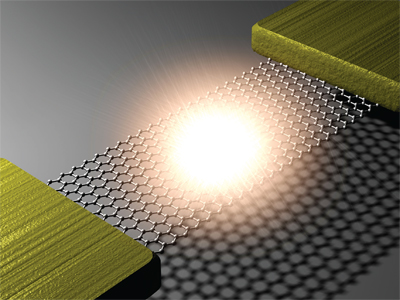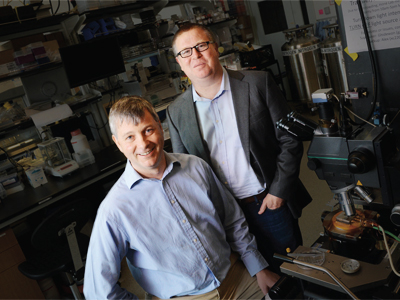James Hone + Colin Nuckolls: Collaborating to Create Novel Materials on the Nanoscale
Collaborating to Create Novel Materials on the Nanoscale
If someone wagers there is nothing new under the sun, it would be best to first consult with James Hone and Colin Nuckolls before taking the bet. After all, their combined focus is to create new materials on the nanoscale that have the potential to solve some of the world’s most persistent problems.
Hone and Nuckolls talk about their work and what's new in the field of nanoscience.
(Video by Jane Nisselson)
Hone, Wang Fong-Jen Professor of Mechanical Engineering, and Nuckolls, Higgins Professor of Chemistry, are director and associate director, respectively, of Columbia University’s new Materials Research Science and Engineering Center (MRSEC), supported by a $15 million, six-year grant from the National Science Foundation. Their goal is to learn about the properties of atoms and molecules and then determine how to assemble these nanoscale building blocks into materials and structures that will define the next generation of medicine, electronics, energy production, and consumer products.
“Nanoscience is a special area in which many disciplines meet because of the complexity of the science,” says Nuckolls, who concentrates his research on creating new materials using chemically designed superatoms. These highly complex designer elements are expected to have unprecedented levels of functionality.

Led by Young Duck Kim, a postdoc in the Hone Lab, a team of scientists from Columbia, Seoul National University, and Korea Research Institute of Standards and Science have recently demonstrated—for the first time—an on-chip visible light source using graphene. They attached small strips of graphene to metal electrodes, suspended the strips above the substrate, and passed a current through the filaments to cause them to heat up, essentially creating the world’s thinnest light bulb.
(Image provided by Young Duck Kim)
“Our MRSEC has preliminary results that are already quite exciting, which demonstrate that these elements have the potential for interplay between thermal, magnetic, and electrical conductivity,” he says.
While Nuckolls works on designing new superatoms, Hone focuses on thinning known materials to the ultimate limit—like graphene, an atomically thin form of graphite that is a single atomic layer of carbon atoms. This two-dimensional material is stronger than a diamond and better able to conduct electricity and heat than any known material. In the MRSEC, Hone and colleagues are stacking it and other 2D materials to create heterostructures, which helps him learn how to control the properties of these nanomaterials to create interfaces that exhibit entirely new electronic phenomena.
“Our work in the MRSEC is examining material in an atomically thin layer, which exposes new properties we have never seen before. Much of our work in nanoscience is like Darwin stepping onto the Galapagos Islands,” says Hone. “There is something new, something never before seen, happening all the time.”
Collaboration between Hone and Nuckolls has resulted in some interesting science that not only helps further insight into the chemistry of graphene, but also helps illustrate the potential for the material as part of next-generation circuitry.

“The secret to life is not giving up,” Olsen said. “It’s not about the money or super-smarts, just your determination.”
(Photo by Eileen Barroso)
“Colin and I worked together to couple carbon nanotubes and DNA and made circuits,” says Hone. That work forged both literal and figurative connections between chemistry, physics, materials science, and biology, which holds promise for a new generation of integrated multifunctional sensors and devices.
That potential for discovery—and Columbia Engineering’s reputation as a collaborative environment—attracts interest from outside the University.
“If you want to tackle big questions—and nanoscience is full of big questions, then you need to work in groups across disciplines,” says Hone. “Here, we welcome collaboration.”
Researchers from a number of institutions of higher education, including City College of New York, Harvard University, Barnard College, Stanford University, and the University of the Virgin Islands, are part of the MRSEC investigations. So too are the Brookhaven National Laboratory, IBM, and DuPont.
“At Columbia, there is a watercooler effect in which we all talk to each other about problems we are working on,” explains Nuckolls. “That give-and-take results in important insight and better understanding among all of us about these new materials.
